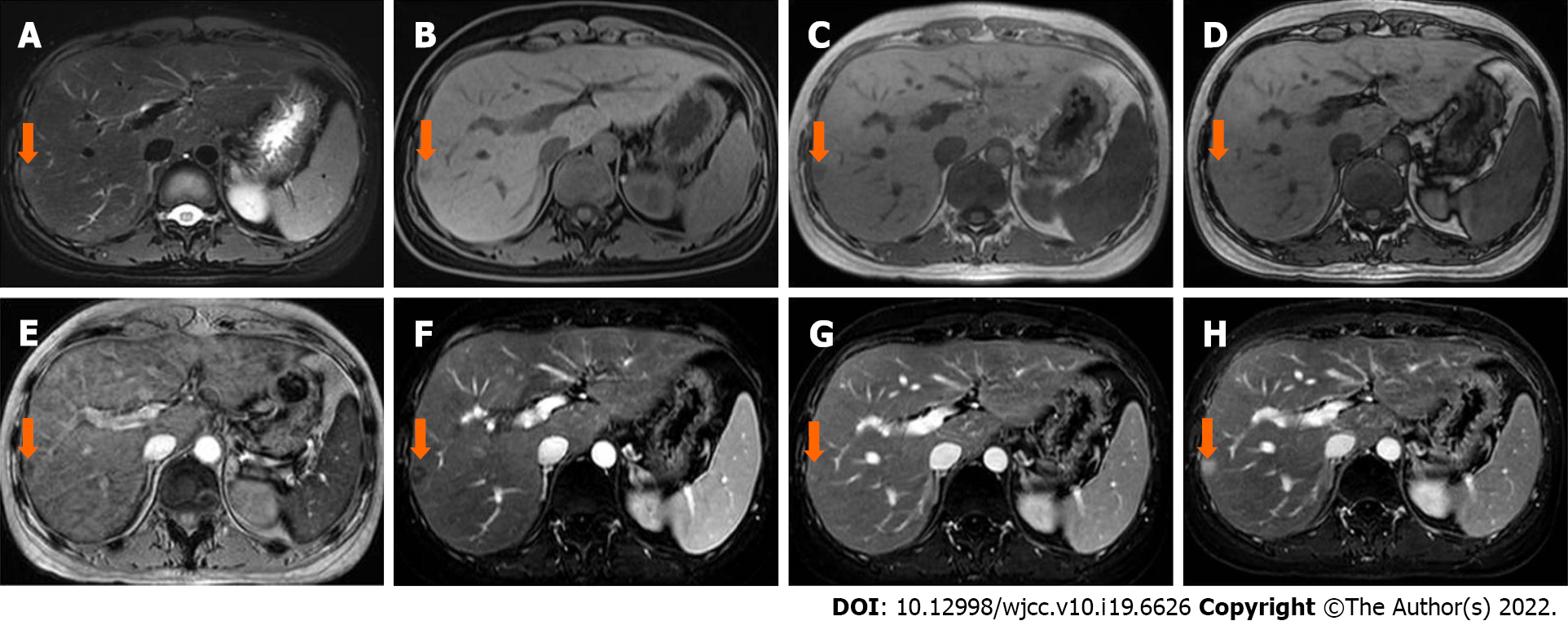Copyright
©The Author(s) 2022.
World J Clin Cases. Jul 6, 2022; 10(19): 6626-6635
Published online Jul 6, 2022. doi: 10.12998/wjcc.v10.i19.6626
Published online Jul 6, 2022. doi: 10.12998/wjcc.v10.i19.6626
Figure 1 An intrahepatic mass (arrow) in segment VIII was found in a 50-year-old female.
A: On unenhanced computed tomography, the lesion was heterogeneously hypodense, with hyperdense foci in the central area; B: The lesion was heterogeneously hyperdense in the arterial phase; C and D: Progressive enhancement in the portal venous (C) and delayed phases (D); E-K: On magnetic resonance imaging, the lesion was heterogeneously hyperintense on T2 weighted image (WI), T2WI-fat saturation (FS) (E and F) and diffusion weighted imaging (DWI) (G), isointense on the apparent diffusion coefficient map (H), hypointense on T1WI-FS (I), avid enhancement in the arterial phase (J) and persistent enhancement in the delayed phase (K); L-R: Corresponding follow-up images five months later showed that the lesion size had increased. Signal drop was seen on the in-phase (L) compared with the out-phase (M) image. The lesion was heterogeneously hypointense on T2WI-FS (N) and DWI (O), homogeneously hypointense on T1WI-FS (P), and showed hypervascular enhancement with delayed enhancement in the arterial (Q) and delayed phase (R), respectively. The surgical pathologic diagnosis was intrahepatic extramedullary hematopoiesis.
Figure 2 A 30-year-old female diagnosed with intrahepatic extramedullary hematopoiesis was confirmed by biopsy.
A and B: The lesion (arrow) located in the subcapsular of segment VI/VII was slightly hyperintense on T2 weighted image (WI)-fat saturation (FS) (A) and slightly hypointense on T1WI-FS (B); C-E: The lesion showed a lower signal intensity on the in-phase (C) than on the out-phase (D) image, and signal loss on susceptibility weighted imaging (E); F-H: In dynamic series, the lesion was mildly enhanced in the arterial phase (F), with areas of progressive and prolonged enhancement in the portal venous (G) and delayed phases (H).
Figure 3 A 52-year-old male diagnosed with intrahepatic extramedullary hematopoiesis was confirmed by resection.
A-D: The lesion located in segment V/VIII (arrow) showed lower signal intensity on the in-phase (A) than on the out-phase (B) image, as opposed to another lesion (the same patient) in segment IV (arrowhead, the surgical pathologic diagnosis was angioleiomyolipoma), which showed higher signal intensity on the in-phase (C) than on the out-phase (D) image; E-H: The lesion (arrow) showed high signal intensity on T2 weighted image-fat saturation (E), with intense enhancement in the arterial phase (F), and was relatively hypointense in the transitional phase (G) and hepatobiliary phase (H).
Figure 4 Intrahepatic extramedullary hematopoiesis in the same patient shown in figure 1.
A: On the photomicrograph (hematoxylin and eosin staining; × 200), megakaryocytes and erythroid cells were scattered within the surgical specimen; B-D: Immunohistochemical staining using CD235 (B), CD61 (C) and MPO (D) markers (× 40) revealed that the cells were positive (brown color) for these markers, respectively.
Figure 5 Intrahepatic extramedullary hematopoiesis in the same patient shown in figure 3.
A: Photograph of the specimen showed the lobular and solid nature of the resected hepatic mass (segment V/VIII), without areas of necrosis and hemorrhage; B: On the photomicrograph (hematoxylin and eosin staining; × 200), granulocytes, megakaryocytes, adipocytes and erythrocytes were distributed within the surgical specimen; C-E: Immunohistochemical staining using CD235 (C), CD61 (D) and MPO (E) markers (× 40) revealed that the cells were positive (brown color) for these markers, respectively.
- Citation: Luo M, Chen JW, Xie CM. Magnetic resonance imaging features of intrahepatic extramedullary hematopoiesis: Three case reports. World J Clin Cases 2022; 10(19): 6626-6635
- URL: https://www.wjgnet.com/2307-8960/full/v10/i19/6626.htm
- DOI: https://dx.doi.org/10.12998/wjcc.v10.i19.6626













